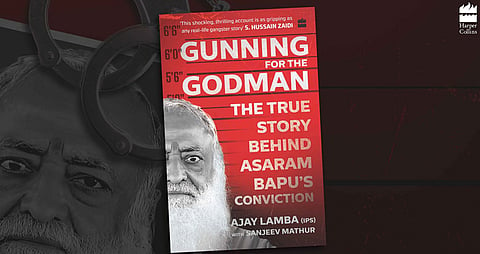Book Review: Gunning For The Godman' - How Asaram Was Done In By The Truth One 16-year-old Dared Tell
The blindness of bhakts: that is the wonder of ‘Gunning for the Godman’, a book detailing the probe that eventually led to the arrest and conviction of Asaram Bapu. The disgraced “godman” despite being exposed as a rapist, had the support of ardent – and violent – followers who made it hard for the law to take its course.
Witnesses were threatened; three were murdered. At least five survived attacks on their lives, two had acid hurled at them. Police officers probing the case were offered inducements, threatened, intimidated. The 72-year-old was arrested in 2013 and sentenced to life in prison in 2018. He now lives in the Jodhpur Central Jail.
One 16-year-old girl stood by her statement and fought for justice – that girl is the real hero of this book by IPS officer Ajay Lamba, then serving as deputy commissioner of police Jodhpur West, who led the team of investigators. Literary agent Sanjeev Mathur assisted the police officer in crafting his experience into a racy read.
The girl’s identity cannot be disclosed, under the law. She remains in the background. She was clearly not Asaram’s first victim. Other residents of the almost 400 ashrams that Asaram ran would narrate that when the aging godman took a fancy to one of his female disciples, he would hurl a fruit at her. That was enough indication for the people in his service to make the girl “available” to the godman.
An injunction against the release of the book was lifted last month by the Delhi High Court, which ruled that there was no ground to prevent the release of a book based on established facts.
There are interesting insights here for those seeking to understand how police forces work. Lamba was given the freedom to put together a team to assist this probe. He met each of the 20 people he had chosen individually, explaining the significance of this probe and assigning roles. Two women, SHO Mukta Pareek and investigation officer Chhaya Mishra, were core members.
Lamba describes how he too felt the immense pressure of it all, when his parents in their village home in Sikar district were threatened, and had to be provided security cover. His wife, in fear, pulled their daughter out of school for a while. His personal life was far from normal on account of the job he was doing, but he thought back to his days in his village school, the enormous opportunities that later opened up for him on account of access to the Navodaya Vidyalaya school system that offered residential schooling at government expense. He felt a huge sense of gratitude, he recounts, for all he had been offered and found in his job a chance to express that gratitude.
Lamba chose his team members with care, looking for integrity and professionalism. The “godman” was arrested 10 days after the complaint was received. Care was taken to ensure that all the evidence presented in court would be irrefutable. Among the lawyers arguing for the godman was Ram Jethmalani, the best known of India’s criminal lawyers.
The police officer could rely also on ordinary friendships. An officer that Lamba had trained with, for instance, called to alert him that Asaram was at the Bhopal airport. Lamba tells of how Asaram was cut to size – during the interrogation in Jodhpur, the “godman” was instructed to get off the comfortable sofa in the guest house and sit on the ground. That sudden, gruff instruction suddenly brought him literally down to earth, and the truth began to flow, “galti ho gai,” he said, admitting guilt.
This book offers interesting insights into policing. There are, though, questions that might spring up in the minds of readers. Why, for instance, is the same Rajasthan Police so inept at cracking the numerous cases of insurance fraud, where poor and often illiterate villagers are scammed of their life savings by powerful corporate interests like ICICI Prudential? Ashok Rathore, who currently heads the Special Operations Group of Rajasthan Police, received training in criminology from the University of Cambridge in the UK. Asked about progress in the insurance fraud probe, he said there was “nothing pending”. None of the accused had been questioned!
‘Gunning for the Godman’ is an account of an investigation; it does not fully explain the godman phenomenon. Sociologists and psychologists have work to do, to unravel the phenomenal power criminals like Asaram and Gurmeet Ram Rahim wielded, in the guise of ‘godmen’.
The 16-year-old girl who proved Asaram’s nemesis – she is a young 23-year-old woman now – is the daughter of a Shahjahanpur businessman; what draws families like that to such ashrams?
The girl and her brother were students at one of Asaram’s ashrams. How many children, unable to go against the grain of their parents’ beliefs, suffer silently at the hands of such perverse men? Asaram was at one time a tea seller in Gujarat. What, one might ask, is it about tea and Gujarat? And while reading, please also keep track of the many donations of land made to Asaram and his ashrams.
- Rosamma Thomas
(The writer is a Pune-based freelance journalist)

